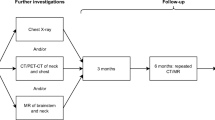Abstract
Background
Unilateral vocal fold paralysis (UVFP) may present as an uncommon complication of extralaryngeal neoplasms, requiring diagnostic scrutiny to seek occult tumors or diseases. The aim of this study was to examine the utility of computed tomography (CT) in evaluating adult UVFP of unknown etiology.
Methods
From January 2010 to December 2011, UVFP was diagnosed in 822 patients at our tertiary-care center. In 634 patients, a readily identifiable cause of the UVFP was evident and therefore there was no need for any imaging; in the remaining 188 patients, the etiology could not be determined. Among this latter group, 153 patients underwent chest radiography (CXR) and contrast-enhanced CT imaging from the skull base to the midchest.
Results
In 36 of the 153 (23.5 %) patients, CT revealed the cause of the UVFP: lung cancer in 12 patients, thyroid carcinoma in 7 patients, skull-base tumor in 4 patients, aortic aneurysm in 4 patients, esophageal cancer in 3 patients, thymus tumor in 2 patients, pericardial effusion in 1 patient, and other neck lesions in 3 patients. CXR and neck ultrasonography also identified the etiology in 14 and 12 patients, respectively. During follow-up after the initial CT, none of the patients with idiopathic UVFP was determined to have an underlying disease that would have explained the paralysis.
Conclusion
CT is a useful single-imaging method for evaluating the etiology of adult UVFP. This approach may reveal occult tumors or previously undiagnosed diseases as the cause of the paralysis, thus improving patient care.



Similar content being viewed by others
References
Sulica L, Blitzer A (2007) Vocal fold paresis: evidence and controversies. Curr Opin Otolaryngol Head Neck Surg 15:159–162
Bielamowicz S, Stager SV (2006) Diagnosis of unilateral recurrent laryngeal nerve paralysis: laryngeal electromyography, subjective rating scales, acoustic and aerodynamic measures. Laryngoscope 116:359–364
Rubin AD, Sataloff RT (2007) Vocal fold paresis and paralysis. Otolaryngol Clin North Am 40:1109–1131
Rosenthal LH, Benninger MS, Deeb RH (2007) Vocal fold immobility: a longitudinal analysis of etiology over 20 years. Laryngoscope 117:1864–1870
Chen HC, Jen YM, Wang CH et al (2007) Etiology of vocal cord paralysis. ORL J Otorhinolaryngol Relat Spec 69:167–171
Ko HC, Lee LA, Li HY et al (2009) Etiologic features in patients with unilateral vocal fold paralysis in Taiwan. Chang Gung Med J 32:290–296
Merati AL, Halum SL, Smith TL (2006) Diagnostic testing for vocal fold paralysis: survey of practice and evidence-based medicine review. Laryngoscope 116:1539–1552
Altman JS, Benninger MS (1997) The evaluation of unilateral vocal fold immobility: is chest x-ray enough? J Voice 11:364–367
Hideki B, Takeshi N, Yasuo H et al (2006) Vocal fold paralysis as a sign of chest diseases: a 15-year retrospective study. World J Surg 30:293–298. doi:10.1007/s00268-005-7959-x
El Badawey MR, Punekar S, Zammit-Maempel I (2008) Prospective study to assess vocal cord palsy investigations. Otolaryngol Head Neck Surg 138:788–790
Wang CP, Chen TC, Lou PJ et al (2012) Neck ultrasonography for the evaluation of the etiology of adult unilateral vocal fold paralysis. Head Neck 34:643–648
Liu AY, Yousem DM, Chalian AA et al (2001) Economic consequences of diagnostic imaging for vocal cord paralysis. Acad Radiol 8:137–148
Robinson S, Pitkäranta A (2006) Radiology findings in adult patients with vocal fold paralysis. Clin Radiol 61:863–867
American Thyroid Association (ATA) Guidelines Taskforce on Thyroid Nodules and Differentiated Thyroid Cancer, Cooper DS, Doherty GM, Haugen BR et al (2009) Revised American Thyroid Association management guidelines for patients with thyroid nodules and differentiated thyroid cancer. Thyroid 19:1167–1214
Moon WJ, Jung SL, Lee JH et al (2008) Benign and malignant thyroid nodules: US differentiation—multicenter retrospective study. Radiology 247:762–770
Conflict of interest
The authors have no conflicts of interest to disclose.
Author information
Authors and Affiliations
Corresponding author
Rights and permissions
About this article
Cite this article
Kang, B.C., Roh, JL., Lee, J.H. et al. Usefulness of Computed Tomography in the Etiologic Evaluation of Adult Unilateral Vocal Fold Paralysis. World J Surg 37, 1236–1240 (2013). https://doi.org/10.1007/s00268-013-1991-z
Published:
Issue Date:
DOI: https://doi.org/10.1007/s00268-013-1991-z




